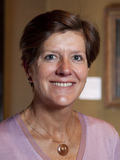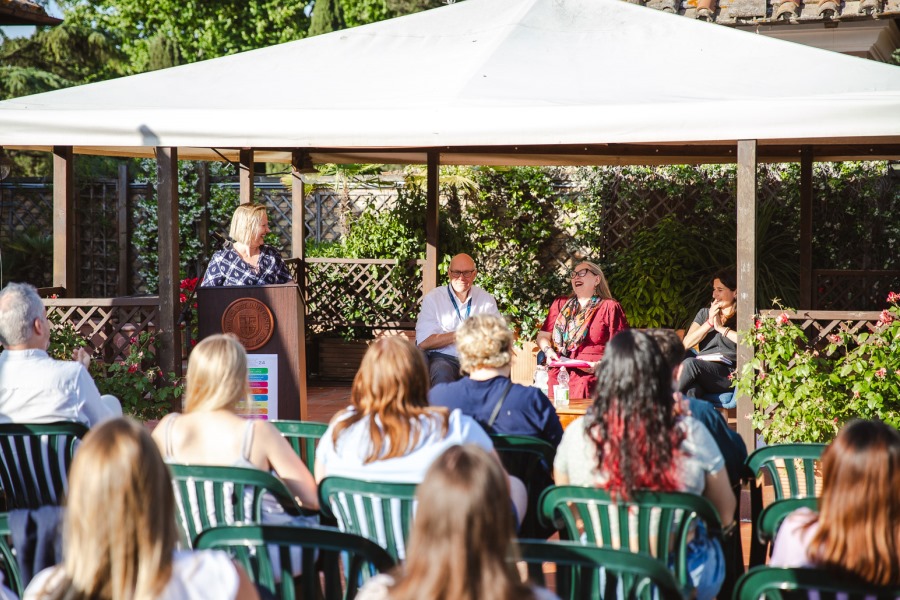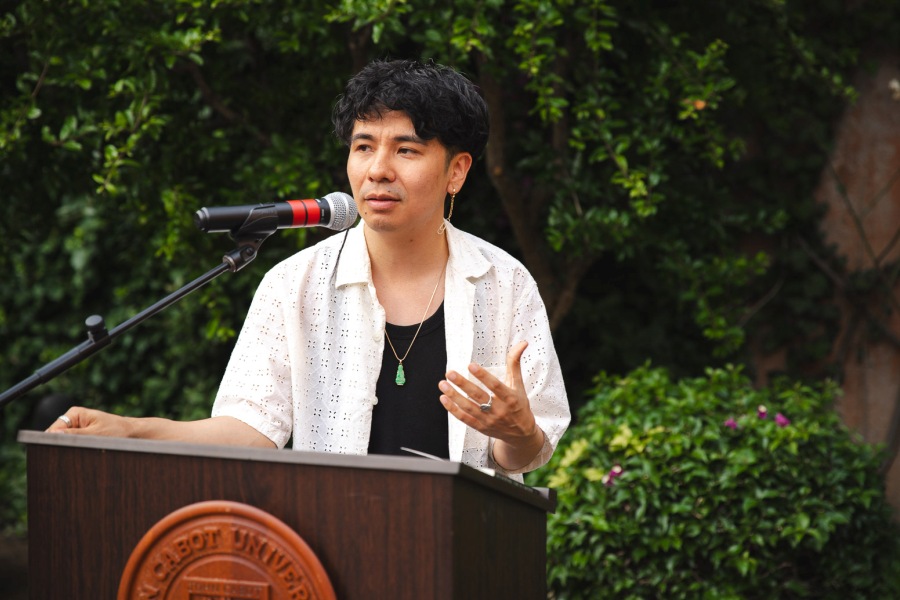Ghosts in the Pavement: Footfall and Pilgrimage by Artist Liz Rideal
On November 4, JCU welcomed Liz Rideal, Professor of Fine Art (Slade School of Fine Art, UCL), who discussed her latest project as well as the technical aspects of her practice combining abstract painting, photography, and digital print on fabric. The lecture was organized by the JCU Department of Art History, the British School at Rome (BSR), and the Slade School of Fine Art, University College London (UCL).

Artist and writer Liz Rideal
Rideal’s current work is inspired by the rich pattern and colors of the medieval Cosmatesque pavements: the style of marble floors arranged in intricate geometrical patterns, often reminiscent of textiles. The project will culminate in a public show of her work at the John Cabot University’s 4m2 Gallery in February 2020.
Opening remarks
Professor Inge Hansen, the Chair of the Art History and Studio Art Department, introduced Professor Rideal and noted how Rideal’s recent work shows her interest in “the sense of the mark left by the human presence.” She also highlighted how Rideal is inspired by traveling and her interest in “merging the academic fields of archaeology, textiles, and experimental painting.”
A case of “serendipity”
Rideal discussed how the title of her lecture (“Ghosts in the pavement: footfall and pilgrimage”) could easily be renamed to “Serendipity.” She said that “while creating art, you can have a ‘plan of attack,’ but there’s always an element from the outside that affects the art.” Rideal recalled how a twist of fate made it possible for her to be where she is. She was awarded a fellowship at the British School at Rome to pursue her work with cloth in relation to Gian Lorenzo Bernini (1598-1680), a great Baroque sculptor and architect. Her artistic exploration led her to Bernini’s staircase in the Palazzo Barberini in Rome. Rideal said that she found “the abstract in a perfectly calibrated space designed by Bernini.” She examined how Bernini worked with those spaces and forms.
After she completed her research, Rideal decided to work with draperies and ancient art. As she put it, “I studied ancient Romans and Etruscans after my BSR fellowship ended in order to have another reason to go back to Rome.” Using BSR collection of the 19th-century photographs of the ancient sites in Rome and the Roman countryside, Rideal decided to locate those places and re-photograph them. One of the sites she visited was the ancient temple and sanctuary of Jupiter Anxur in Terracina, close to Rome.
By coincidence, the Terracina Cathedral has very fine Cosmatesque pavements, but it was the church of San Benedetto in Piscinula in Trastevere that was to form the inspiration for her interest in the floor design. “Serendipity again,” she said. Rideal was fascinated by the floors that were executed in a so-called Cosmati or Cosmatesque style. Rideal summed up the Cosmatesque floors as “expensive, tailor-made, beautiful environments,” which are “as recognizable as Andy Warhol silk prints.”
Multiplicity of work
“I was trying to find the right place to work,” Rideal said. In the end, she started her work in Basilica di San Crisogono in Trastevere. “As an artist, you fail all the time. You have to recognize that some ideas don’t work, and some do” Rideal added. She explained how the repeating patterns of the floors constituted a new challenge for her work. She used diverse media in her experimentations, including cloths, Japanese paper, pastels, graphite and wax. Rideal said that some of her techniques when continuing the work in her studio included “banging the cloth onto the paper, layer after layer,” creating action paintings which were also a study of colors. Working with layers, Rideal said, emphasizes the multiplicity in the work. For example, she took to her studio the wax rubbings that she did on the floors of the church and painted them over. “The rubbings are taken in Medieval Roman churches and are in a sense a record of the footfall of bygone visitors. Reworked in my studio the images constitute an amalgam of artistic methodology and they exist as a hybrid form that echoes spaces redolent of hidden histories.”
In her photographic work, the detail of the pavements is juxtaposed by the texture and movement of silk fabrics. “My photographs suggest a fleeting human presence through freeform flying fabric, the bright colors held in momentary tension against a background of immutable stone; churches, ruins or pavements.”
Rideal talked about how she was able to trace the forgotten stories buried in fragments of marble. She showed her photographs of marble fragments with reused, fragmentary inscriptions, as well as cropped fragments of columns included as a part of the pavement. Rideal said that those pieces are half-hidden elements and half-told stories that she was rediscovering among “very strictly designed spaces.” These fragments were utilized for the church floors and became coherent elements of the whole, yet simultaneously did not belong there.
“In choosing the space,” Rideal said while answering the questions from the public, “being restricted by the materials is a good thing,” but the “serendipity and chance” come first, she added. “I like dealing with something that is very fixed. The idea of texture and space is interesting, but the texture comes from what I bring into the space rather than the space itself.” Rideal said that she is particularly interested in adding the movement into her works. This allows her to bring in the chaos, to invade the space, and to subvert it. “You look at something you know in a new way,” she said. “The ghosts come from the invisible layers of time,” Rideal explained.
Liz Rideal is an artist and writer. Since 1985, her work has been displayed in 44 solo exhibitions in both public and private art galleries across Europe and America together with 5 catalogue publications and 20 public commissions. Her works can be found in major art museums around the world. Rideal is also an acclaimed author, her publications include: Mirror/Mirror: Self-portraits by Women Artists (Watson-Guptill, 2001); Insights: Self-portraits (The National Portrait Gallery, 2005); Madam & Eve: Women Portraying Women (Laurence King Publishing, 2018), and many more.





